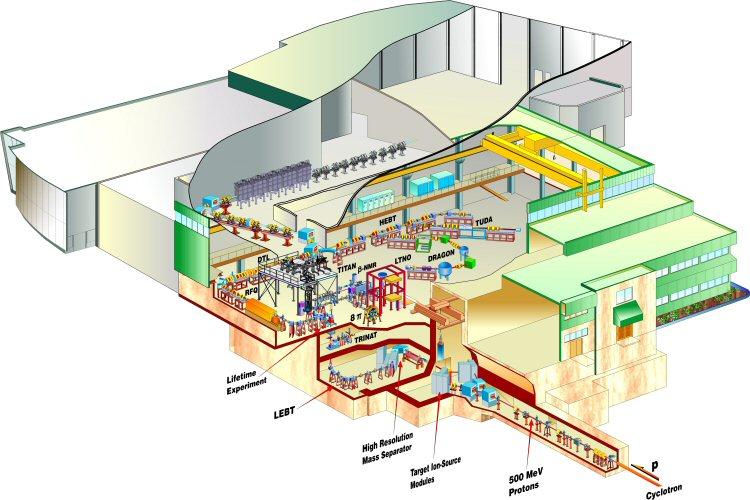|
User experiment requests are evaluated twice a year by an independent peer-review. It decides which requests for detector and facility use at ISAC by experimenters is granted. Experimenters with approved experiments can also set up their own instrumentation at experimental end stations. The experimental facilities presently available for use at TRIUMF state of the art (ISAC Backgrounder) and span a wide range of resaerch from nuclear astrophysics, nuclear structure and fundamental symmetries to material- and life sciences.
Targets & Ion Sources (TIS)
The accelerator division's Targets & Ion Sources deptartment (Alexander Gottberg) is tasked with:
(i) R&D in on-line targest & ion sources, (ii) target production & operation, (iii) remote handling and all related infrastructure, and (iv) laser applications.
The group carries the R&D and construction for
(v) the ARIEL photo-fission electron target (AETE) station, as well as (vi) the ARIEL protron target (APTW) station and all related infrastructure - which is based on hermetically sealed target modules and explores new technolgies and concepts for rare isotope production.
The group delivers radioactive ion beams and developes (a) new isotope beams, of (b) higher purity, (c) higher intensity and (d) highest reliability. In the near future TIS will have to simultaneous operate 1 ISAC target station, and two additional target stations AETE and APTW to deliver 3 rare isotope beams simultaneously in a 24/7 operation mode.
Details of radioactive isotope beams delivered are available in the classic (pre COVID'19), and new ISAC yields database (Peter Kunz). The off-line ion source OLIS (Christopher Charles) has become an ion source that is scheduled identical to the RIB on-line sources. It serves with pilot beams for accelerated RIB experiments, as well as stable beam experiments.
Isotpe yields are delivered yields, measured at the ISAC yield station - located in the ISAC1 experimental hall as well as the ARIEL yield station located at ground level by the injection beamlines from ARIEL to ISAC. Typical on-line ion sources for RIB are (i) surface ion source (SIS), (ii) electron impact ion source (FEBIAD), and the element selective (iii) resonance ionization laser ion source TRILIS, which an also be operated with (iv) ion-guide laser ion source, that allows for isobar free beams.
RIB experimental facilities: ISAC-I (low-energy and medium-energy RIB)
In the ISAC-I facility, 500 MeV protons at up to 100 μA can be steered onto one of two production targets to produce radioactive isotopes. The isotopes pass through a heated tube to a source where they are ionized, accelerated off the source’s high-voltage platform at up to 60 kV and sent through a mass separator to select the ion beam of choice. The beam is transported in the low-energy beam transport (LEBT) electrostatic beam line to either the low-energy experimental area or to a series of room-temperature accelerating structures to the ISAC-I medium-energy experimental area.
Experimental areas in ISAC I and ISAC II have (x) facilities that are maintained and managed by TRIUMF research scientists - and welcome new collaborators, as well as (xi) free, multi-purpose end stations, which allow new experiments to be installed and receive RIB.
In the ARIEL era facilities and end-stations are planned to be operated with simultaneous RIB to experiments in the "low-energy", "medium-energy" and/or the "high-energy" area - potentially tripling the science output and reducing scheduling conflicts. This delivery mode is already tried with simultaneous use of ISAC RIB and OLIS beams to different experiments.
Experimental facilities and experiments at ISAC-I include:
| GRIFFIN (decay spectrometer) | TITAN (Penning trap & MR-TOF) | TRINAT (neutral atom trap) | spin polarized beams (polarizer) | β-NMR (high field) |
| DRAGON (detector of recoils and gammas) | TITAN (EBIT charge breeder) | francium PNC (neutral atom trap) | collinear fast-beam laser spectroscopy | β-NQR (low field) |
| OSAKA (decay spectroscopy) |
RIB experimental facilities: ISAC-II (high-energy) post accelerated RIB
The rare-isotope beams produced in the ISAC-II facility are transported in the low-energy beam transport (LEBT) electrostatic beam line and sent via a switchyard to either the low-energy experimental area or to a series of room-temperature accelerating structures in the ISAC-I medium-energy experimental area. For high-energy delivery, the drift tube linac (DTL) beam is deflected north along an S-bend transfer line to the ISAC-II superconducting linear accelerator (SC-linac) for acceleration above the Coulomb barrier (5-11 MeV/u). TRIUMF began developing superconducting accelerator technology in 2001 and is now a leader in the field with a demonstrated accelerating gradient significantly above other operating facilities.
Experimental facilities at ISAC-II include:
| DESCANT | SHARC | IRIS | |
| EMMA (recoil mass separator) | TIGRESS | HERACLES |
ISAC-I/II
Some elaborate experimental facilities can be moved between the ISAC-I and ISAC-II experimental halls:
| DSL | TACTIC | TUDA (TRIUMF-UK detector array) |
contact: lassen at triumf.ca

